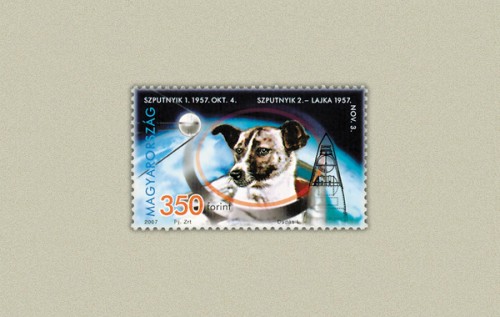
1. MAGYAR - ŰRKUTATÁSI ÉVFORDULÓK - 50 ÉVE BOCSÁTOTTÁK FEL AZ ELSŐ MESTERSÉGES HOLDAT ÉS 50 ÉVE JÁRT AZ ELSŐ ÉLŐLÉNY A VILÁGŰRBEN - Bélyeg rendelési kód: 2007 év bélyegei kompletten
2. ENGLISH - ANNIVERSARIES OF SPACE RESEARCH FIRST SATELLITE LAUNCHED 50 YEARS AGO AND FIRST LIVING CREATURE IN SPACE 50 YEARS AGO - Order code of the stamp: 2007 Year stamps complete
3. GERMAN - SPACE JUBILÄUM - 50 JAHRE löschte das erste künstliche Mond und führte in den ersten 50 Jahren OF SPACE ORGANISMEN - Marke die sprechstunde kode: 2007 Jahr Briefmarken komplett
1. MAGYAR - ŰRKUTATÁSI ÉVFORDULÓK - 50 ÉVE BOCSÁTOTTÁK FEL AZ ELSŐ MESTERSÉGES HOLDAT ÉS 50 ÉVE JÁRT AZ ELSŐ ÉLŐLÉNY A VILÁGŰRBEN
A Magyar Posta Zrt. alkalmi bélyeg kibocsátásával köszönt két jelen-tős űrkutatási évfordulót: 50 éve bocsátották fel az első mesterséges holdat és 50 éve járt az első élőlény a világűrben.
A rakétakutatás alapjait már a 20. század elején lefektette Konsztantyin Ciolkovszkij, Robert Goddard és Hermann Oberth, azonban az űrkorszak kezdetét 1957-re teszik, amikor az első mesterséges holdat (Szputnyik 1) útnak indították. Azóta sok műhold, űrszonda, űrhajó, űrállomás és más űreszköz jutott el a világűrbe.
Az űrkutatás személyzetes és személyzet nélküli űreszközökkel egyaránt megvalósult. Az űrhajósok nélküli szerkezetek a felderítést és a beprogramozott műveleteket, az összetettebb tevékenységet az emberekkel repülő űrhajók és űrállomások végzik.
Az első sikeres személyzet nélküli küldetés 1957. október 4-én volt, majd 1957. november 3-án Lajka kutya volt az első pályára állított állat.
Az alkalmi bélyegképen az 50 évvel ezelőtt felbocsátott első mesterséges hold, a Szputnyik 1, középen Lajka kutya, tőle jobbra pedig a Szputnyik 2 oldalnézeti metszete látható. Az alnyomaton a kék bolygó részlete tűnik elő. A bélyeghez tartozó alkalmi borítékon a rakétakilövés pillanata került megörökítésre, az alkalmi bélyegzőn látható montázson a Szputnyik 1, Szputnyik 2 és Lajka kutyát ábrázoló stilizált rajz tűnik elő.
Megjelenési időpont: 2007. február 6.
Forrás: Philatelia Hungarica Kft., Magyar Posta
2. ENGLISH - ANNIVERSARIES OF SPACE RESEARCH FIRST SATELLITE LAUNCHED 50 YEARS AGO AND FIRST LIVING CREATURE IN SPACE 50 YEARS AGO
Magyar Posta is issuing a commemorative stamp to celebrate two major anniversaries of space research: the launching of the first satellite and the first space journey by a living creature, both 50 years ago.
The foundations of rocket research were laid in the early 20th century by Konstantin Tsiolkovsky, Robert Goddard and Hermann Oberth, but the start of the space age is considered to be 1957, when the first satellite, Sputnik 1, was launched. Since then many satellites, probes, shuttles, space stations and other equipment have been put into space.
Space research has used both manned and unmanned craft and devices. Unmanned equipment is used for discovery and programmed operations, while more complex activities are performed by manned spacecraft and space stations.
The first successful unmanned mission was on 4 October 1957, then on 3 November 1957 Laika the dog became the first living creature in orbit.
The commemorative stamp shows the first satellite launched 50 years ago, Sputnik 1, Laika the dog in the centre and to the right a cross-section from the side of Sputnik 2. In the background a section of the blue planet is shown. The first day cover to go with the stamp captures the moment of the lift off of a rocket, while the design of the commemorative postmark is a stylised montage of Sputnik 1, Sputnik 2 and Laika the dog.
Source: www.wikipedia.org
Date of issue: 6 February 2007
3. GERMAN - SPACE JUBILÄUM - 50 JAHRE löschte das erste künstliche Mond und führte in den ersten 50 Jahren OF SPACE ORGANISMEN
Die Ungarische Post Co. Stempel Ausstellung gelegentliche begrüssen, eine deutliche Steigerung in diesem Bereich zwei Jubiläen: 50 Jahre, um die erste künstliche Mond zu vor 50 Jahren und war der erste Mensch im Weltraum.
Rakétakutatás die Grundlagen bereits im 20. Jahrhunderts legten die Konstantin Ziolkowski, Robert Goddard und Hermann Oberth, sondern der Anfang 1957 durch űrkorszak, als die ersten künstlichen Satelliten (Sputnik 1) befördert wurden. Seit damals hatte, viele Satelliten und Raumfahrzeuge, Satelliten, im Weltraum und andere Raumfahrzeuge der Raum erreicht.
Személyzetes und unbemannte Raumfahrtmissionen űreszközökkel beides erreicht. Die Strukturen der Astronauten ohne Nachweis und die programmierten Maßnahmen führte die Komplexität der Tätigkeiten, die von Menschen unter Satelliten und Raumstation Mannschaftsräumen.
Die erste erfolgreiche unbemannte Mission 1957. 4. Oktober wurde dann 1957. 3. November Hündin Laika war das erste Tier in der Umlaufbahn.
Die gelegentliche Stempel der vor 50 Jahren felbocsátott ersten künstlichen Satelliten, Sputnik 1 in der Mitte Hündin Laika, Sputnik 2 ist auf der rechten Seite Blick auf die Kreuzung zu sehen. Das Drucken im Hintergrund die Details des Planeten blau erscheinen. Die Briefmarken sind gelegentliche Momente waren Verewigung rakétakilövés Umschlag, kann der Stempel in die gelegentliche Montagen von Sputnik 1 Sputnik 2 und Hund Laika Darstellung einer stilisierten Zeichnung erscheinen zu sehen.










